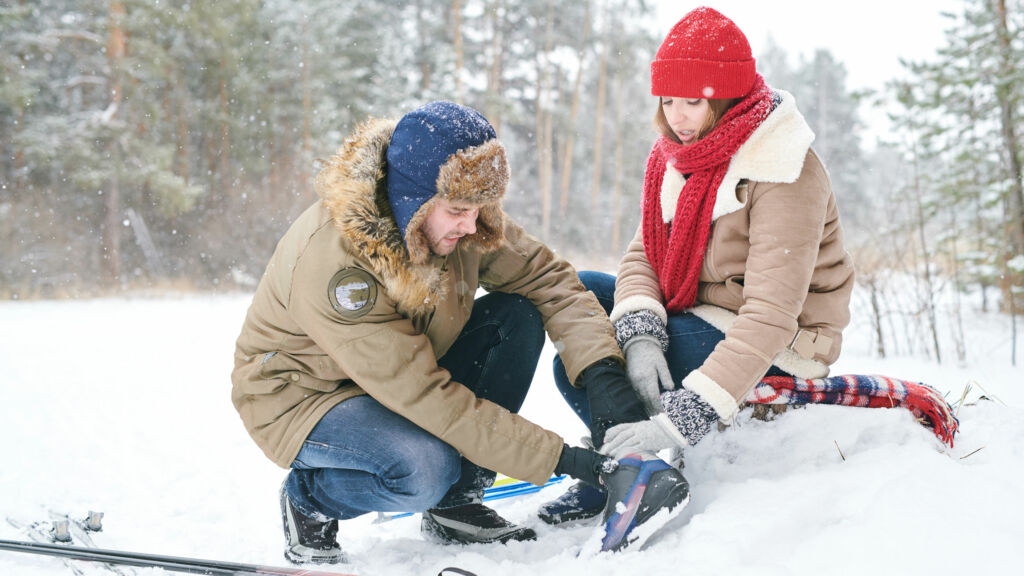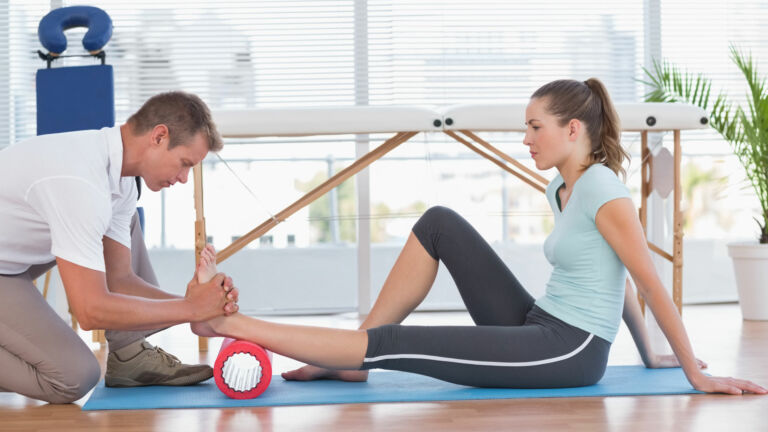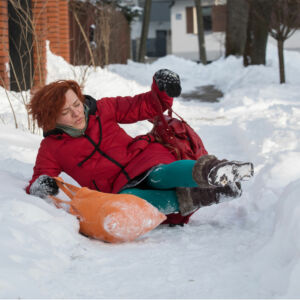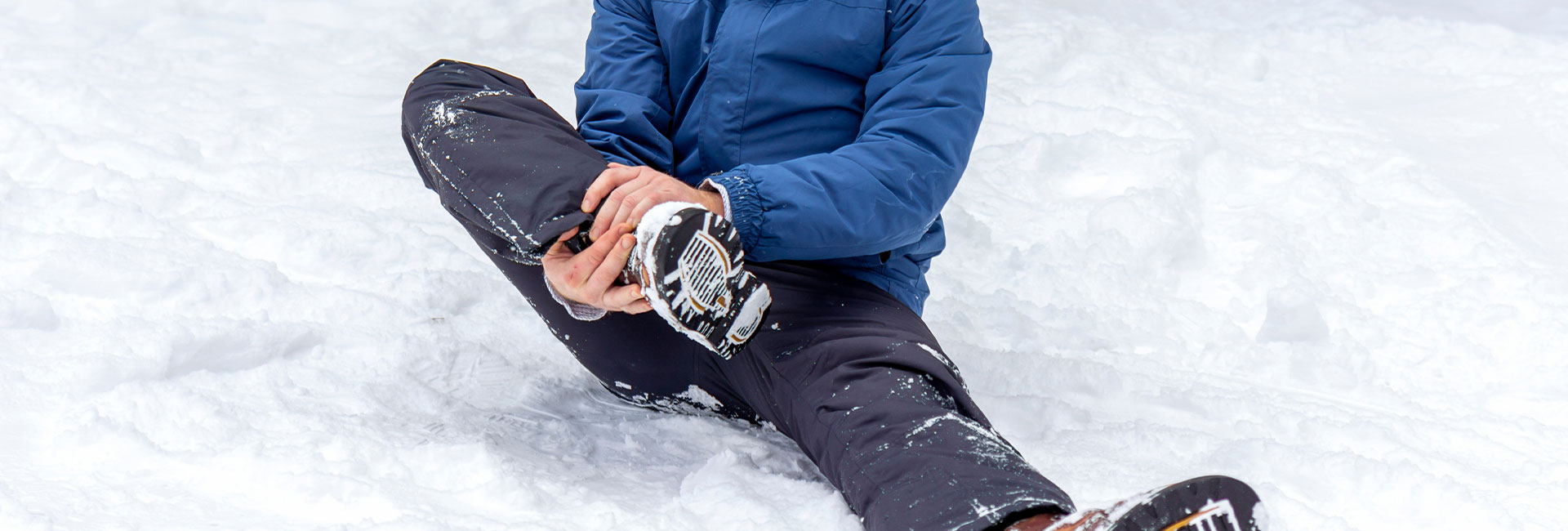Ankle sprains are, unfortunately, a common injury, with thousands occurring every single day across the U.S. This number rises during winter months as sidewalks get slippery and future PT patients carry too many grocery bags from the car. It is rare to meet someone who has not sprained their ankle at least once – it affects all of us regardless of age, activity level, job or sport. Given how widespread this injury is, and how it can lead to other injuries down the road, it’s worth understanding the pathology of ankle sprains as well as ways to help bulletproof our ankles from future sprains.
Our ankles and feet are often undertrained and neglected parts of our bodies. Unfair, really, when you think about how they carry us from place to place every single day. We expect them to carry on often without a thought for a stretch, massage or training. Similar to when we jam our thumb, we don’t realize how much we use our ankles until we sprain them and then our bodies remind us of exactly how important they are.
Ankle Sprains Defined
How do I know if I sprained my ankle?
Sprained it? Twisted it? Rolled it? Not playing a game of “Bop It” here, I think we’re all talking about the same thing. An ankle sprain occurs when the ligaments on the inside, or more commonly the outside, of our ankle get stretched beyond their normal capacity.
Ankle sprains are graded 1 through 3 with less serious ones considered a grade 1 (mild), sprains with partial tearing considered grade 2 (moderate) and completely torn ligaments grade 3 (severe).

How do I know how bad my ankle sprain is?
If your ankle is swollen and painful after you injured it, it is most likely sprained. But if you’re wondering how to know just how severe it is, the grading system can help. If you can’t bear weight, seek medical care right away.
Grading Ankle Sprains
- Grade 1: The ankle will likely be less swollen and tender at the site of the ligament injury. These sprains often heal on their own with minimal treatment and simply allowing adequate time for recovery.
- Grade 2: The swelling, bruising and pain will likely be significant. However, that is not always the case, and generally, there is a poor correlation between the extent of an injury and the degree of pain that is experienced. With a partial tearing of a ligament, there will be more instability and often these injuries benefit from a brace or splint to help minimize the stress on the ankle.
- Grade 3: There is a complete tear of the ligament in grade 3 sprains, where the degree of pain, bruising and swelling is increased. A brace or walking boot may be recommended in these cases. A longer recovery timeline is also expected in these cases and a course of physical therapy is usually recommended to address the underlying deficits and assist the individual in returning to their prior level of function.
In most cases, the sprained ligament is the ATFL (anterior talofibular ligament) with the PTFL (posterior talofibular ligament and deltoid ligament) involved less frequently. These ligaments normally provide stability to our ankle joint and prevent excess motion from occurring. However, in the worst cases, ligaments are overstretched or potentially torn. Immediately after this, the body goes into damage control by sending inflammatory factors to the injured area.
Usually, when we sprain our ankles, we only damage our ligaments and soft tissue structures but, in some cases, an avulsion fracture or other break can occur. You will likely know something serious like this has happened if you cannot put any weight on your ankle and in this case, it is advised you seek immediate medical care.
Healing Timeline for Ankle Sprains
The moment an ankle sprain occurs, the inflammatory phase begins, which can last a few days to a week and includes blood vessel coagulation, and the release of cytokines and growth factors. This is followed by the proliferation phase during which granular tissue forms and fibroblasts lay down collagen. This typically lasts from a day to a few weeks. The last phase of healing is the maturation phase where scar tissue is laid down, further healing occurs over a few weeks to years. However, most ankle sprains don’t take years to heal, and, in most cases, you’ll be back to your activities within a few weeks as your body works through phases of healing.
Will an ankle sprain heal on its own?
Like most things in our bodies – things tend to heal on their own. But without encouragement, they often heal in less-than-optimal ways or they can take longer to heal than we wish. Physical therapy minimizes recovery time so you can enjoy life comfortably (and with more stability!). Physical therapists also educate you on any changes in treating acute ankle sprains to continue your healing journey.

What should I do after an ankle sprain?
While sprained ankles are a common injury – sometimes occurring with a simple misstep during a casual walk, sometimes as the result of landing wrong after taking a jump shot in a competitive basketball game – every situation is different. Knowing what to do after an ankle injury is important.
Old RICE vs new PEACE & LOVE
RICE is the old acronym standing for Rest, Ice, Compression and Elevation. It has come under scrutiny in recent years with icing and anti-inflammatory use being rejected tenets of the previous approach. You might notice that there is some overlap in the previous recommendations and the new ones, but there are also significant differences. The British Journal of Sports Medicine in 2019 published a new study with the acronym PEACE & LOVE – which stands for Protect, Elevate, Avoid anti-inflammatories, Compress, Educate and then LOVE which stands for Load, Optimism, Vascularization, Exercise.
We’ll dive a little deeper into what PEACE and LOVE might look like in your recovery and rehabilitation.
- Protect: Unload and avoid activities that increase pain during the first few days.
- Elevation: Elevate the injured ankle above the heart
- Avoid Anti-Inflammatories: Avoid icing and anti-inflammatory medicine. These may impact long-term healing if used too early in the healing process.
- Compression: Use elastic bandages, tape or braces to reduce swelling.
- Education: See a physical therapist to learn about new protocols, and to engage in active rehabilitation, which is preferred to passive rehab.
- Load: Loading the sprained ankle promotes tissue repair and remodeling. Return to normal activities as soon as possible.
- Optimism: Good patient expectations are associated with better outcomes.
- Vascularization: Cardiovascular activity can improve healing times by pushing increased blood flow into injured tissues.
- Exercise: Exercise can help restore strength, flexibility, and proprioception. Strong evidence supports exercising to help heal and prevent additional injuries.
As previously noted, icing recommendations have changed. In recent years we have learned a lot more about the inflammatory process our bodies go through after injury and how well evolved our bodies are at healing from injury. We better understand that some swelling is beneficial and that allowing our bodies to naturally heal is better than stunting it with ice and anti-inflammatories. If you need to use ice as a way of reducing pain without pain medication that is of course an accepted use.
So, you sprained your ankle – Now what?
Your first line of defense after an ankle sprain is to begin the PEACE & LOVE protocol and allow your body time to recover. This does not take the place of seeking medical treatment and advice if that is necessary. Please check with your doctor or physical therapist before beginning a rehabilitation program.

Physical therapy is an ideal option after ankle sprains, especially grade 2 and grade 3 sprains. Physical therapy can help manage swelling and limited ankle range of motion, improve healing of the injured ligaments, address strength and balance deficits, and assist patients in returning to their hobbies, activities and sports of choice.
Often manual therapy is indicated to perform ASTYM treatments or joint mobilizations to improve ankle mobility. Exercises are prescribed based on your pain levels and ability to perform exercises with good form. Your therapist will also help determine if you should use an ankle brace during normal activity or just during more strenuous activity.
Bulletproof Ankles
How do I prevent repeating an ankle sprain?
You may have heard that once you’ve sprained your ankle, odds are you’ll do it again. While it is true that the risk of re-spraining an ankle is significantly higher in the first two years after the initial sprain, there are some things you can do to reduce your risk.
It’s not uncommon for individuals who sit at a computer for the majority of their day to ignore their ankles, even if they have a regular exercise routine they incorporate into their lives. Unfortunately, this leads to reduced ankle and calf flexibility, two things that are essential for ankle health.
Not only does stiffness increase the risk of ankle sprains, but it can also cause other common injuries such as Achilles tendinitis and plantar fasciitis. In fact, our entire lower body can be impacted by stiff ankles and calves, including our knees, hips and low backs.
Conversely, when the ankle has good flexibility, it allows all the crucial joints above it to function seamlessly and painlessly.

It’s impossible to avoid every misstep in life, but if we commit to taking care of our ankles and maintaining their flexibility as well as their strength and mobility, then we can decrease the risk of those missteps ending with an ankle sprain.
A physical therapist can assess your situation and will work with you to create a customized plan of care that includes a series of exercises designed to improve ankle health. An ideal ankle exercise routine will not focus solely on the ankles, but will also incorporate balance training, hip and glute strengthening and the all-important core. By taking care of these various body parts, and making sure we have good strength and flexibility from our heads to our toes, we can reduce the risk of ankle sprains.
Hopefully you have found this information valuable. If you have questions or if you sprained your ankle and think you need treatment – find a Therapeutic Associates Physical Therapy clinic near you and they will get you in quickly for an examination and treatment. The sooner the treatment begins, the sooner you will be back on your feet!

Start your physical therapy journey today.
As physical therapists, we know the importance of movement for overall health and well-being. From injury recovery to achieving optimal performance, our passion is to help every patient reach their goals and live an active, pain-free life. Get started with PT today!

